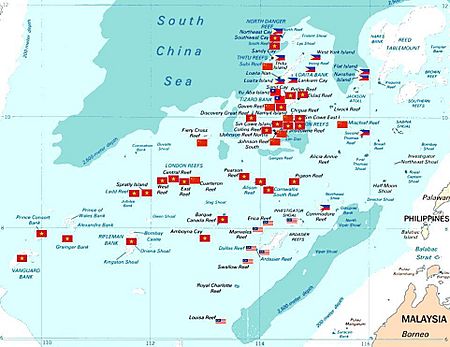Territorial disputes in the South China Sea facts for kids
Territorial disputes in the South China Sea are disagreements over who owns certain islands and parts of the sea. Several countries claim these areas. These countries are Brunei, China, Taiwan, Indonesia, Malaysia, the Philippines, and Vietnam.
The disagreements are about islands, reefs, and sea areas in the South China Sea. This includes places like the Spratly Islands, Paracel Islands, and Scarborough Shoal. Some disputes also involve the waters near the Natuna Islands in Indonesia. There are even disputes outside the South China Sea, like the Senkaku Islands in the East China Sea.
About US$3.37 trillion worth of global trade passes through the South China Sea every year. This is a huge amount, making up one-third of all sea trade worldwide. For China, 80 percent of its energy imports and nearly 40 percent of its total trade goes through this sea.
Countries want control of these areas for several reasons. They want to keep or gain rights to fishing. They also want to explore for and use crude oil and natural gas found under the seabed. Controlling these areas is also important for shipping lanes, which are like highways for ships. Keeping these shipping lanes safe is a big concern.
Contents
History of the Disputes
In 1932, France officially claimed the Paracel and Spratly Islands. Both China and Japan protested this claim. On April 6, 1933, France took control of the Spratlys. They announced that these islands were now part of French Indochina.
In 1947, the government of China at the time, called the Republic of China, said that most of the South China Sea belonged to them. In 1949, a new government took over China after a civil war. This new government, the People's Republic of China (PRC), said they also had this same claim.
Island Building and International Response
In 2013, China started building artificial islands in the Spratly and Paracel Islands. Other countries like Vietnam and the Philippines had built small islands for decades. However, China's efforts were much bigger. From 2014 to 2016, China created more new island land than all other countries combined throughout history. By 2016, China had also placed military equipment on one of its artificial islands.
Vietnam's island building has been slower and seen as defensive. Because of this, Vietnam has faced less international criticism.
China's actions in the South China Sea have been called "salami slicing" or "cabbage wrapping" strategies. This means taking small steps over time to gain more control. Since 2015, the United States and other countries like France and the United Kingdom have sent ships to the area. These are called "freedom of navigation operations" (FONOP). They show that these countries believe ships should be able to move freely in international waters.
In July 2016, an international court ruled against China's claims in the sea. This ruling was made under the United Nations Convention on the Law of the Sea (UNCLOS). The court did not decide who owned the islands. It also did not draw sea borders. Both China and Taiwan said they did not accept this ruling. They insisted that the issues should be solved through talks between the countries involved. In January 2022, the United States Department of State said China's claims in the South China Sea were "unlawful."
Main Areas of Disagreement
The disputes are about both sea borders and islands. There are several different disagreements, and different countries are involved in each.
- The Nine-Dash Line: China claims a large area of the South China Sea using a map line with nine dashes. This area overlaps with the sea claims of Brunei, Indonesia, Malaysia, the Philippines, Taiwan, and Vietnam.
- Vietnamese Coast: There is a disagreement over the sea border along the coast of Vietnam. This involves China, Taiwan, and Vietnam.
- North of Borneo: The sea area north of Borneo is disputed by China, Malaysia, Brunei, the Philippines, and Taiwan.
- South China Sea Islands: Many islands, reefs, and shoals are claimed by China, Taiwan, and Vietnam. These include the Paracel Islands, Pratas Island, Macclesfield Bank, Scarborough Shoal, and the Spratly Islands. Parts of these areas are also claimed by Malaysia and the Philippines.
- North of Natuna Islands: The sea area north of Indonesia's Natuna Islands is disputed by China, Indonesia, Taiwan, and Vietnam.
- West of Palawan and Luzon: The sea border off the coasts of Palawan and Luzon is claimed by China, the Philippines, and Taiwan.
- Sabah Area: The land and islands of Sabah, including Ambalat, are disputed by Indonesia, Malaysia, and the Philippines.
- Luzon Strait: The sea border and islands in the Luzon Strait are disputed by China, the Philippines, and Taiwan.
See also
 In Spanish: Conflicto territorial en el mar de la China meridional para niños
In Spanish: Conflicto territorial en el mar de la China meridional para niños
- Continental Shelf
- First island chain
- Great wall of sand
- North Borneo dispute
- South China Sea
- South China Sea Islands
- Spratly Islands
- Spratly Islands dispute
- Senkaku Islands
- Senkaku Islands dispute
- Territorial claims in the Arctic
- Territorial claims in Antarctica
- Chinese expansionism
- 21st Century Maritime Silk Road


